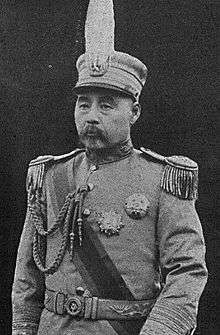Feng Guozhang
| Feng Guozhang | |
|---|---|
 | |
| President of the Republic of China | |
|
In office 6 August 1917 – 10 October 1918 | |
| Preceded by | Li Yuanhong |
| Succeeded by | Xu Shichang |
| Vice President of the Republic of China | |
|
In office June 7, 1916 – July 1, 1917 | |
| President | Li Yuanhong |
| Preceded by | Li Yuanhong |
| Succeeded by | Post abolished |
| Personal details | |
| Born |
7 January 1859 Hejian, Hebei, Qing Dynasty |
| Died |
12 December 1919 (aged 60) Beijing, Republic of China |
| Nationality | Chinese |
| Political party | Zhili clique |
| Other political affiliations | Progressive Party |
| Alma mater | Baoding Military Academy |
| Occupation | Military Officer |
Féng Guózhāng, (simplified Chinese: 冯国璋; traditional Chinese: 馮國璋; Wade–Giles: Feng Kuo-chang; courtesy: Huafu 華甫 or 華符) (January 7, 1859 – December 12, 1919) was a key Beiyang Army general and politician in early republican China. He held the office of Vice-President and then President of the Republic of China. He is considered the founder of the Zhili Clique of Warlords that vied for control of northern China during the chaotic Warlord era.
Early life
Feng Guozhang was born to a peasant family in Hejian, Hebei (then called "Zhili"). His family had fallen on hard times and was forced to sell its property to educate its sons; however being the fourth son, Feng was unable to complete his education due to costs.[1] He reputedly had to survive part of his early life by playing the violin in disreputable theatres.[2]
Early career
Without much recourse, Feng enlisted himself in the army, then undergoing reforms that would eventually create the Beiyang Army under the command of Yuan Shikai. Feng performed admirably and came to the notice of a battalion commander who referred him to the Baoding Military Academy.[2] It was at Baoding where he would make key friends and allies who would serve him well later on. In 1895, Feng was sent to Tokyo to serve as a military attaché and came to the attention of Yuan Shikai, who began to groom him to be one of his supporters within the Beiyang Army. However, when Yuan was forced to retire in 1908 by Manchu nobles fearful of his growing power, Feng managed to maintain a good relationship with both sides.[2]
In October 1911, after the outbreak of the Wuchang Uprising, he was ordered by the Qing Court to suppress the revolution in Wuhan. Feng held back the Beiyang Army until Yuan Shikai was restored to power and then proceeded to capture Hankou and Hanyang from the revolutionaries in the Battle of Yangxia. In the battle, he ordered the razing of Hankou. Then, Feng following orders from Yuan Shikai, halted the Qing military's advance on Wuchang. Yuan then negotiated the abdication of the Last Emperor and became the provisional president of the newly founded Republic of China in 1912. Feng followed Yuan into the new government and was honored for his contribution to the Xinhai Revolution even though he took active part in suppressing the uprising.
Politics
Feng broke with Yuan Shikai when he later attempted to make himself emperor. Yuan made Feng a Duke, but Feng declined this title. Yuan then sent an admiral to assassinate Feng but the admiral tipped him off and was himself murdered. Feng then moved to Nanjing where joined the anti-Yuan opposition. His name was prominently missing from the list of proposed successors in Yuan's will.
Feng then served as vice president under Li Yuanhong. During the occupation of Beijing by Zhang Xun, Feng served as acting president, a position he kept when Li formally resigned.
He was sworn president of the Republic of China on August 1, 1917 but his constitutionality was challenged as the National Assembly was not reconvened to recognize it.
On August 14, China entered World War I on the side of the Allies after growing evidence of the German Empire's support for Zhang's coup was uncovered as well as intense lobbying by Premier Duan Qirui. He sent about 135,000 in labor battalions to the Western Front, Mesopotamia, and German East Africa. Troops were sent into Russia to assist the Allied intervention. Sun Yat-sen set up a rival government in Guangzhou during September 1917 and also declared war later that month in a failed attempt to get international recognition. Feng wanted to peacefully resolve the north-south conflict which led to Duan resigning in protest. Due to pressure from the Anhui clique, he brought Duan back into the premiership. Feng finished the five-year term started by Yuan in 1913 on October 10, 1918 and died in Beijing of illness.
See also
References
Citations
Sources
- Gray, Jack (2002). Rebellions and Revolutions: China from the 1800s to 2000. New York: Oxford University Press. pp. 168–169. ISBN 978-0-19-870069-2.
| Political offices | ||
|---|---|---|
| Preceded by Li Yuanhong |
President of the Republic of China 1917–1918 |
Succeeded by Xu Shichang |